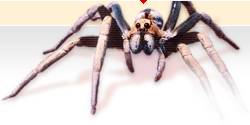
Debunking an urban myth: The jumping spider Maratus cannot fly!
by Julianne M. Waldock, Western Australian Museum
(This article is derived from the text of a poster presented at the International Congress of Arachnology, Brazil, 2007. The poster, including all pictures, can be downloaded here.)
The first description of Salticus volans by O. Pickard-Cambridge (1874) referred to the collector's comments that he "has observed them elevating and depressing the [abdominal] flaps, and also actually using them as wings or supporters to sustain the length of their leaps", and led to the creation of the specific epithet 'volans' for this spider. This has lead to a belief that these spiders actually fly or glide, and has permeated into the general literature on Australian spiders. This species is now placed in the genus Maratus, a group that is characterized by the possession of abdominal flaps in males. Although the females are drab in colouration, the males are generally brightly coloured with iridescent scales and setae. During an on-going systematic revision of the genus Maratus, the behaviour of several members of this genus has been observed. In all cases, the courtship behaviour involves the male 'dancing' around the drab female (which has no abdominal extensions) with the abdomen raised and abdominal flaps expanded in display to the receptive female. This courtship behaviour includes intense shaking of the expanded abdomen and repeated hitting of the substrate with the elongated third legs as well as prancing side-to-side in front of the female. The abdominal flaps are only ever expanded in the final stages of the mating dance. The gliding or flying function attributed to the abdominal flaps has never been corroborated, and it seems highly likely that the brightly coloured abdominal flaps are solely used in courtship behaviour.
Salticus volans (also known as Saitis volans) has since been transferred to the genus Maratus Karsch by Marek Zabka in 1991 (Zabka 1991).
The mating 'dance' of Maratus pavonis entails the male approaching a female if she is receptive, he stops briefly to raise a third leg vertically which is then lowered jerkily and the other third leg is raised and lowered in the same manner. If the female is still interested the male then moves forward and becomes more excited, eventually raising both third legs at the same time and jerking them down stiffly onto the substrate (this can be heard as a tap when the substrate is a dried leaf or other hard substance), at this point he jumps forward. This is repeated many times.
When the male is about three centimetres away from the female, he suddenly raises his abdomen and unfolds the side flaps, thus creating an almost circular, brightly coloured 'target'. This is flanked by the third legs, held aloft, erect and straight. In addition the male vigorously shakes his flared abdomen at the female, jerking from side to side and imperceptibly closing the distance between them. Receptive females appear to be entranced by this performance and when the male finally is within touching distance, the female is immobile and allows him to climb over her cephalothorax, turn her abdomen over and insert a pedipalp. This entire procedure can take up to two hours and when the male has discharged both pedipalps he quickly moves away from the immobile female which seems to take several seconds to recover and move off herself.
There are at least 20 species in the genus Maratus. Truly, these spiders are Peacock Spiders rather than 'flying spiders'!
ReferencesPickard-Cambridge, O. 1874. On some new genera and species of Araneidea. Annals and Magazine for natuaral History (4) 14, 169-183.
Zabka, M. 1991. Studium taksonomiczno-zoogeograficzne nad Salticidae (Arachnida: Araneae) Australii. Wyzsza Szkola Rolniczo-Pedagogiczna W Siedlcach Rozprawa Naukowa 32, 1-110.

